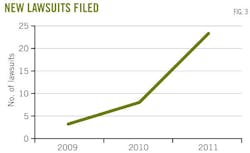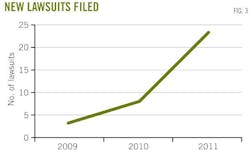P. 4 ~ Continued - Trends emerge on hydraulic fracturing litigation
Displaying 4/6
View Article as Single page
As of the writing of this article, none of the up-to 30 cases currently pending before US courts has reached final judgment; so it is difficult to estimate the viability of these lawsuits and their claims. Additionally, many of the cases are simply too early in the litigation process for defendants to seek an early dismissal or summary judgment requesting the judge dispose of certain claims.
Such motions, however, are pending in several courts. For instance, the primary defendant in one of the Pennsylvania cases recently brought a motion to dismiss the claims against it. The motion was denied for each claim save one for gross negligence, which is not a recognized cause of action in Pennsylvania.
Further, given that most cases are still in the early stages of discovery, plaintiffs have not had to identify their expert witnesses or the scientific evidence that will support their claims. This will be of paramount importance and may be another opportunity for the defendants to seek to have certain testimony or claims dismissed.
Of course, the problem for the industry is that even if the claims do not pan out, the cost to defend such lawsuits, in the aggregate, could be sizable.
Fig. 3 shows the new lawsuits filed in the US by year.
Government enforcement
Landowners, while the most plentiful plaintiffs, are not the only group seeking remedies for alleged damages caused by hydraulic fracturing. In what is becoming its own trend, government regulatory agencies and officers have commenced actions against the operators of fracturing ventures to enforce state interests and regulations.
In a separate action relating to the same operation as one of the privately filed Pennsylvania cases, the Pennsylvania Department of Environmental Protection (PDEP) initiated its own lawsuit against the natural gas company, on behalf of other plaintiffs whose water wells were allegedly contaminated by methane as a result of the company's nearby fracturing activities.
This action settled in December 2010, with the families represented by PDEP receiving $4.1 million in compensation, and the energy company agreeing to pay a $500,000 penalty to the agency.
While the settlement permitted the company to resume its hydraulic fracturing activities, it allowed the families who had joined the separate privately-financed action to maintain their suit.
Even more recently, on May 17, 2011, another energy company agreed to pay a fine of nearly $1 million to the PDEP for alleged regulatory violations that included contamination of water and a tank fire resulting from its fracturing operations.
Pennsylvania is not the only state authority to seek damages from energy companies that have violated state regulations. As on May 2, 2011, the Maryland Office of the Attorney General announced that it also intended to sue a hydraulic fracturing operation for injunctive relief and civil penalties, under the Resource Conservation and Recovery Act and Clean Water Act, for spilling thousands of gallons of fracturing fluids into a tributary of the Chesapeake Bay.
In a move that could be emblematic of things to come, the federal government has become involved in the common-law regulation of hydraulic fracturing. In a separate case filed in federal court in Texas, EPA brought suit against a hydraulic fracturing company, alleging that the company released contaminants in two water wells that according to the EPA may present an imminent and substantial endangerment to the health of persons.
Displaying 4/6
View Article as Single page

